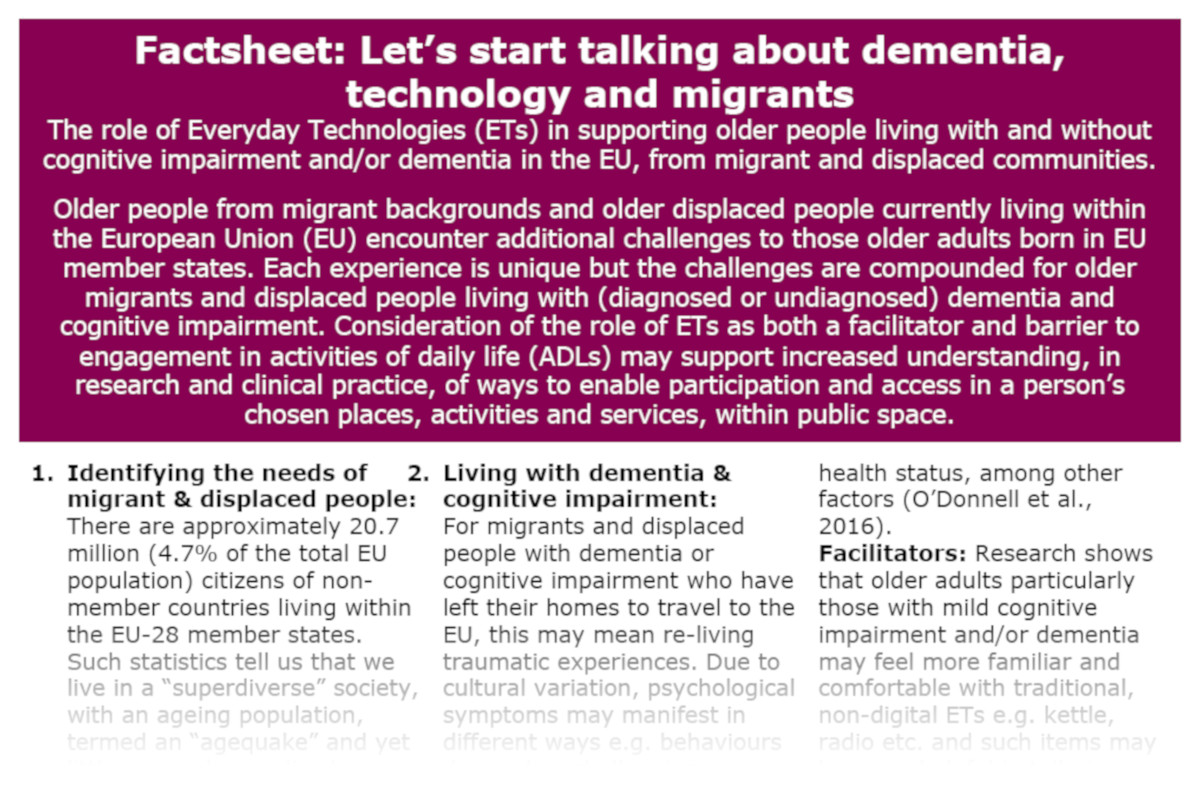Technology in everyday life
Guidance
Service providers should counter the stigmatising effect of not having access to, or not being a skilled user of, Everyday Technologies, for people with dementia and consider strategies to enhance participation, providing offline and online choices for all public services.
Explanation and Examples
Interviews were performed with 128 older people with and without dementia in the UK, and 69 people with and without dementia in Sweden. In both the UK and Swedish studies, people with dementia reported significantly lower use of Everyday Technologies compared to older people without dementia. People with dementia also reported significantly lower participation in places and activities within public space. Reduced ability to use Everyday Technologies was linked to reduced participation in places visited and activities within public space for people with dementia. Community-based consultations with older people with and without dementia across London showed that Everyday Technologies can provide opportunities to participate in services, e.g. eHealth and online banking. However, without face-to-face or written options (e.g. offline), people with dementia are at risk of stigma associated with digital exclusion. Barriers to participation in their everyday lives can lead to social isolation.
Read more >
Guidance
Technology companies and developers should involve more diverse groups of people living with dementia or caring for people with dementia, in all stages of design, development and implementation of technologies. They should also consider existing contexts before introducing them.
Explanation and Examples
Consultations explored the ways in which Everyday Technology can be both an enabler and disabler, among people living with dementia, or providing care for people with dementia, from minority and migrant communities within the EU (Germany and Greece). The consultations highlighted the need for more contextually-relevant Everyday Technologies. This includes consideration of existing contexts before introducing technologies or technology interventions e.g. eHealth, finance or social apps. Consultees reported the need to identify existing levels of access and ability to use Everyday Technologies (e.g. possession of technological devices and digital literacy etc.) as well as access to infrastructures to support their use (e.g. internet connection, battery charging facilities and face-to-face support). Everyday Technology use is influenced by contextual and cultural factors. Technology companies and developers need to involve a more diverse group of people living with dementia or caring for people with dementia (e.g. from different cultural and socio-economic backgrounds, urban and rural environments etc.) throughout all stages of technology development.
Read more >
Social Health Domain 3: Technology to promote social participation
Guidance
Implementing assistive technology could be promising in long-term care to address loneliness in dementia, but further studies are needed to tailor assistive technology to people living with dementia in different care settings and to investigate its effect on loneliness.
Explanation and examples
Active & Assisted Living (AAL) technology aims to support coping with the consequences of dementia. A scoping review was conducted to learn if and how AAL addresses loneliness in people living with dementia in long-term care. Although, only one study focused directly on the impact of AAL technology on loneliness, findings suggest that AAL were used in the context of psychosocial interventions and proved to have had an impact on loneliness in people living with dementia. It remains unclear why loneliness was almost never included as an outcome in technology studies. Since we were not able to derive clear effects of assistive technology on loneliness from the included studies, we recommend using loneliness outcome measures in future intervention studies into AAL technology.
Read more >
Guidance
Technological solutions that can safeguard the social health of nursing home residents with dementia should be implemented as an integrated part of caregiving procedures. This requires formally incorporated technology guidelines and continuous training of staff. As developing and implementing technology to promote social participation faces substantial barriers as long as social health is not recognized on equal terms as the physical and mental health domains, first, social health needs to be acknowledged as a priority which requires major efforts at the societal-, organizational and individual levels.
Explanation and examples
Cross-sectional data from a national online survey conducted among German nursing homes, on the impact of the COVID-19 pandemic, showed that efforts were made to ensure social participation among residents with dementia, and the use of technology in doing so.A large proportion of respondents observed an increase in at least one Behavioural and Psychological Symptom in Dementia (BPSD) in residents with dementia. Many reported that social activities in the nursing home were cancelled, which was due to COVID-19 cases and staff shortages from 5 % and up, revealing just how easily neglectable social health strategies in nursing homes are. Half of all respondents reported having had no formal training in the use of social technology to engage their residents with dementia. Although more than 70% had provided opportunities for using technology for social purposes, the low frequency of established procedures seems to indicate ad hoc solutions to ensure the social health of residents with dementia.
At the micro-, meso- and macro level requirements were identified to promote social participation using technology. These requirements revealed that integrating technological solutions in institutional settings, requires efforts at individual-, organisational and societal level.
Read more >



